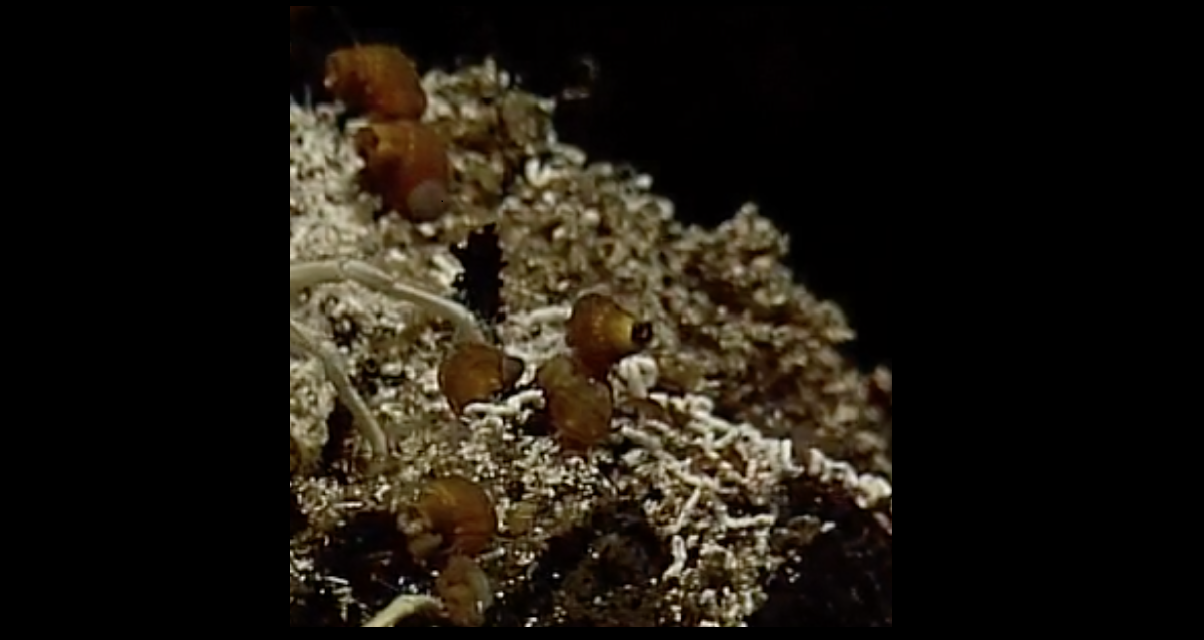The most common type of marine snail (Phylum Mollusca, Class Gastropoda) at Axial is a Limpet, one of the primary organisms that inhabits the hydrothermal vent chimneys. Another snail, the Glob Snail is also very common, though considerably smaller and more difficult to see.
Juan de Fuca Limpet (Lepetodrilus fucensis)

Limpets are a group of marine snails, members of Class Gastropoda. Lepetodrilus fucensis, often referred to as the Juan de Fuca Limpet is the common limpet found on Axial Seamount, and it is the most abundant macrofaunal organism found on Axial’s hydrothermal vents. However, due to their small size (~10 mm) these limpets rank third in terms of Axial’s biomass. They are most abundant on sulfide chimneys, and are often attached to the abundant tube worms. They are also found occasionally on basalt lava surfaces.
This limpet species has multiple feeding strategies: grazing, suspension feeding, and obtaining organic material from endosymbiotic bacteria. It is common to see many specimens vertically stacked on one another, allowing them better ability to suspension feed. This stacking characteristic makes them good competitors for space on a vent. They appear to have no major predator at Axial Seamount.
References:
Tunnicliffe, Verena, and Maia Tsurumi. "Tubeworm-associated communities at hydrothermal vents on the Juan de Fuca Ridge, northeast Pacific." Deep Sea Research Part I: Oceanographic Research Papers: 611-629.
http://www.pmel.noaa.gov/eoi/nemo/explorer/bio_gallery/biogallery-Info.00022.html
Glob Snail (Depressigyra globulus)

The second most dominant species of Gastropod at Axial Seamount is the Glob Snail.
A tiny snail with a brown high-spiral shell, it is commonly found living among the limpets and tube worms on hydrothermal vents.
References:
https://pangea.stanford.edu/projects/marve/bio_gallery/biogallery-Info.00023.html
Unidentified Nudibranch

Nudibranchs (also known as sea slugs) are a type of shell-less mollusk in class Gastropoda that are often equipped with vividly bright colors. They cannot see the colors themselves, however; they can only see light and dark. They are an incredibly diverse group with over 3000 different species, and live anywhere from the intertidal to the deep sea. Sea slugs eat using something called a radula, which is a toothed structure that is used to scrape prey from the rocks that they are clinging to. They have been known to be somewhat picky about their diet – certain nudibranchs may only eat certain types of prey, despite being carnivorous creatures. Nudibranchs can be anywhere from microscopic in size to 1.5 feet in length, and their lifespan varies from a few weeks to a year.
Very little is known about deep-sea nudibranchs, as they are very different to find and study at extreme depths. These deep-sea nudibranchs were found on a few dives at Axial Seamount; the species in these photos are currently unidentified.
Reference:
Kennedy, J. (2019, December 13). Astounding nudibranch facts. ThoughtCo. Retrieved December 13, 2021, from https://www.thoughtco.com/facts-about-nudibranchs-2291859.
